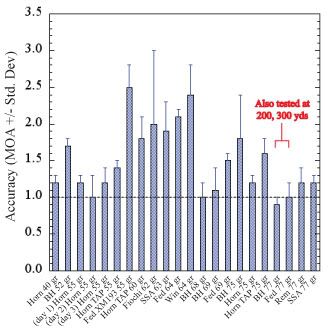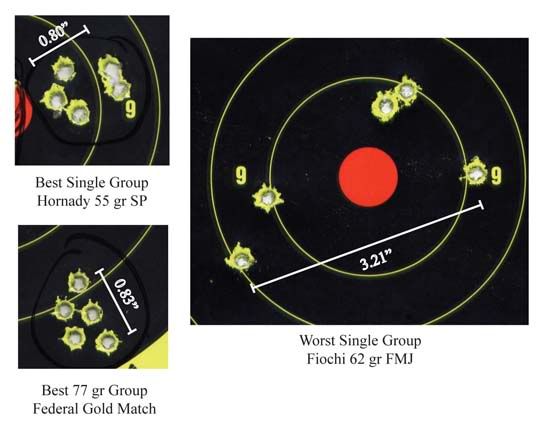I posted this report recently on the Sig Forum site. Sorry to Sniper's Hide members for the "sloppy seconds", but I was unaware of the existence of Sniper's Hide at the time. I guess the ghillie suits are working! In any case, it was suggested out to me that there might also be some interest in this report here.
I was attracted to the Sig 556 DMR primarily because I have two 556 pistols and I've been very pleased with the platform and performance. So I looked into the DMR a little further and a question arose almost immediately.
Because the 556 DMR has a 21" heavy barrel with a 1 in 10" twist, I was unsure whether it would effectively stabilize longer (heavier) loads. After finding a wide range of owner reports online stating that their DMRs would handle anywhere from 68 gr up to 77 gr loads, I decided to find out for myself what the new DMR shot the best. Based on the twist rate, my initial guess was that it would prefer loads in the mid to upper 60 gr range, but not the heavier stuff.

Weapon System: Sig 556 DMR, 21" heavy barrel with a 1 in 10" twist rate, aluminum Quadrail foregrip, Magpul PMAG 30 MAGLEVEL magazines
Optic: Nightforce NXS 3.5-15 x 50 (F2), Zero Stop, Mil-Radian turrets, MLR reticle (setting = 15X)
Optic Mount: LaRue Tactical SPR/M4 1.93" QD (LT-135)
Benchrest: Caldwell Lead Sled Solo with 25 lb. weight bag
The testing of various ammunition took 3 days to complete. Weather conditions were very similar each day (hot as crap, high humidity, little wind). I used 3 to 5 rounds to zero the weapon, then shot 3 groups of 5 rounds each at 100 yds, allowing a few minutes between groups to cool the barrel down. The weapon was cleaned between each ammo tested. As an internal control, I shot the Hornady 55 gr SP load each of the 3 days to ensure that the conditions (or my shooting) didn't vary widely between the different range trips. The maximum spread of each 5 shot group was measured (center to center), then the mean determined +/- standard deviation. Finally, I converted the values to MOA (divide by 1.0472) and rounded to the nearest two significant figures. The data at 100 yds are shown in Table I below.

I should note that "flyers" (and there were a few) were all included in the spread measurements. Surprisingly, two of the best groupings were obtained using Black Hills and Federal 77 gr match ammo. Perhaps more suprising, most of the loads in the low to mid 60 gr range shot poorly. The Hornady 55 gr SP loads that were shot on each of the 3 days were very consistent between range trips, indicating that my shooting and/or conditions did not affect performance on different days. Also, the standard deviation for at least two thirds of the ammunition tested was less than 20% of the average spread, indicating reasonable consistency between groups. For those whom are not crazy about tabular data like myself, I have also shown the results in graphical form below (Figure 1).

Figure 1
Images of the best single group, the best 77 gr single group and the worst single group are shown in Figure 2 below.

Figure 2
Because 100 yds may not have been enough distance for the low twist rate to dramatically affect the stabilization of the 77 gr loads, I also shot the two best of these (Black Hills, Federal) at 200 and 300 yds. The results are shown in Table II below.

My conclusion from this test is that regardless of its slow twist rate, the 556 DMR is perfectly capable of stabilizing 77 gr loads out to 300 yds. Although the best average grouping I obtained was 0.9 MOA with the Black Hills 77 gr, I should point out that many of the groups of 5 shots had a "flyer" that markedly increased the maximum spacing for that group. If I had measured the best three shots from each group, I estimate that the accuracy would easily be in the 0.5 MOA range. This is most likely the fault of the shooter. In fact, two of the three groups of the Federal 77 gr at 300 yds had three shots that fell well under one inch. I suspect that in the hands of a more experienced marksman, the DMR is capable of well under 1.0 MOA accuracy. My overall take is that this is a pretty accurate weapon...capable of shooting 1.0 MOA in my hands, maybe a lot better with more practice as my shooting improves. I don't think I can safely say it is a nail driver at this point, but again, that is more likely my skill, rather than the limitations of the weapon. But best of all, it was a hell of a lot of fun doing the range test.
I was attracted to the Sig 556 DMR primarily because I have two 556 pistols and I've been very pleased with the platform and performance. So I looked into the DMR a little further and a question arose almost immediately.
Because the 556 DMR has a 21" heavy barrel with a 1 in 10" twist, I was unsure whether it would effectively stabilize longer (heavier) loads. After finding a wide range of owner reports online stating that their DMRs would handle anywhere from 68 gr up to 77 gr loads, I decided to find out for myself what the new DMR shot the best. Based on the twist rate, my initial guess was that it would prefer loads in the mid to upper 60 gr range, but not the heavier stuff.

Weapon System: Sig 556 DMR, 21" heavy barrel with a 1 in 10" twist rate, aluminum Quadrail foregrip, Magpul PMAG 30 MAGLEVEL magazines
Optic: Nightforce NXS 3.5-15 x 50 (F2), Zero Stop, Mil-Radian turrets, MLR reticle (setting = 15X)
Optic Mount: LaRue Tactical SPR/M4 1.93" QD (LT-135)
Benchrest: Caldwell Lead Sled Solo with 25 lb. weight bag
The testing of various ammunition took 3 days to complete. Weather conditions were very similar each day (hot as crap, high humidity, little wind). I used 3 to 5 rounds to zero the weapon, then shot 3 groups of 5 rounds each at 100 yds, allowing a few minutes between groups to cool the barrel down. The weapon was cleaned between each ammo tested. As an internal control, I shot the Hornady 55 gr SP load each of the 3 days to ensure that the conditions (or my shooting) didn't vary widely between the different range trips. The maximum spread of each 5 shot group was measured (center to center), then the mean determined +/- standard deviation. Finally, I converted the values to MOA (divide by 1.0472) and rounded to the nearest two significant figures. The data at 100 yds are shown in Table I below.

I should note that "flyers" (and there were a few) were all included in the spread measurements. Surprisingly, two of the best groupings were obtained using Black Hills and Federal 77 gr match ammo. Perhaps more suprising, most of the loads in the low to mid 60 gr range shot poorly. The Hornady 55 gr SP loads that were shot on each of the 3 days were very consistent between range trips, indicating that my shooting and/or conditions did not affect performance on different days. Also, the standard deviation for at least two thirds of the ammunition tested was less than 20% of the average spread, indicating reasonable consistency between groups. For those whom are not crazy about tabular data like myself, I have also shown the results in graphical form below (Figure 1).

Figure 1
Images of the best single group, the best 77 gr single group and the worst single group are shown in Figure 2 below.

Figure 2
Because 100 yds may not have been enough distance for the low twist rate to dramatically affect the stabilization of the 77 gr loads, I also shot the two best of these (Black Hills, Federal) at 200 and 300 yds. The results are shown in Table II below.

My conclusion from this test is that regardless of its slow twist rate, the 556 DMR is perfectly capable of stabilizing 77 gr loads out to 300 yds. Although the best average grouping I obtained was 0.9 MOA with the Black Hills 77 gr, I should point out that many of the groups of 5 shots had a "flyer" that markedly increased the maximum spacing for that group. If I had measured the best three shots from each group, I estimate that the accuracy would easily be in the 0.5 MOA range. This is most likely the fault of the shooter. In fact, two of the three groups of the Federal 77 gr at 300 yds had three shots that fell well under one inch. I suspect that in the hands of a more experienced marksman, the DMR is capable of well under 1.0 MOA accuracy. My overall take is that this is a pretty accurate weapon...capable of shooting 1.0 MOA in my hands, maybe a lot better with more practice as my shooting improves. I don't think I can safely say it is a nail driver at this point, but again, that is more likely my skill, rather than the limitations of the weapon. But best of all, it was a hell of a lot of fun doing the range test.




